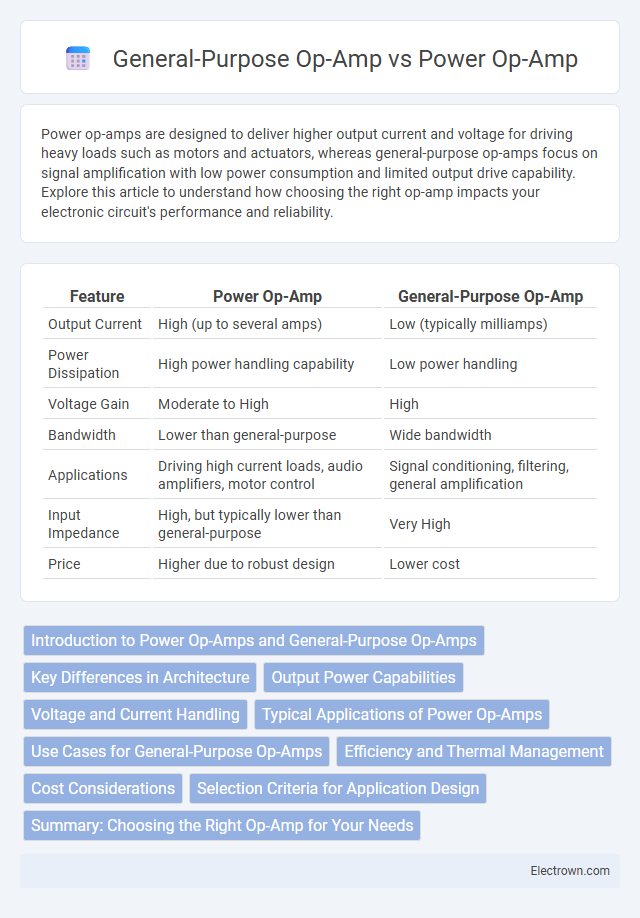Power op-amps are designed to deliver higher output current and voltage for driving heavy loads such as motors and actuators, whereas general-purpose op-amps focus on signal amplification with low power consumption and limited output drive capability. Explore this article to understand how choosing the right op-amp impacts your electronic circuit's performance and reliability.
Table of Comparison
| Feature | Power Op-Amp | General-Purpose Op-Amp |
|---|---|---|
| Output Current | High (up to several amps) | Low (typically milliamps) |
| Power Dissipation | High power handling capability | Low power handling |
| Voltage Gain | Moderate to High | High |
| Bandwidth | Lower than general-purpose | Wide bandwidth |
| Applications | Driving high current loads, audio amplifiers, motor control | Signal conditioning, filtering, general amplification |
| Input Impedance | High, but typically lower than general-purpose | Very High |
| Price | Higher due to robust design | Lower cost |
Introduction to Power Op-Amps and General-Purpose Op-Amps
Power op-amps are designed to drive high current loads and deliver higher power output, making them ideal for applications like audio amplifiers and motor control. General-purpose op-amps prioritize versatility, offering moderate input impedance, gain, and bandwidth suitable for signal conditioning and low-power applications. Choosing the right op-amp depends on your need for power handling versus precision and flexibility in circuit design.
Key Differences in Architecture
Power op-amps feature a robust output stage designed to deliver high current and drive low-impedance loads, whereas general-purpose op-amps prioritize voltage gain and precision with limited output current capability. Their internal architecture includes larger output transistors and enhanced thermal management to handle increased power dissipation. In contrast, general-purpose op-amps utilize smaller, lower-power transistors optimized for low noise and high input impedance rather than high output drive.
Output Power Capabilities
Power op-amps deliver significantly higher output power capabilities compared to general-purpose op-amps, often providing several watts of output current to drive heavy loads such as speakers or motors. General-purpose op-amps typically handle low-power signals with limited output current, suitable for signal conditioning or amplification in low-load environments. Your choice should depend on the required output power and load demands to ensure optimal performance and reliability.
Voltage and Current Handling
Power op-amps are designed to handle higher voltage and current levels compared to general-purpose op-amps, making them suitable for driving heavy loads such as speakers and motors. Your choice of an op-amp depends on the application's voltage and current requirements, with power op-amps typically operating at voltage ranges up to +-60V and delivering output currents exceeding several amperes. In contrast, general-purpose op-amps usually support lower voltage levels around +-15V and output currents in the milliamps range, ideal for signal processing but not for power-intensive tasks.
Typical Applications of Power Op-Amps
Power op-amps are typically used in applications requiring high current output and robust performance, such as motor control, audio amplification, and power supply regulation. These devices handle heavy loads and deliver significant power to speakers, actuators, and other high-demand systems. In contrast, general-purpose op-amps are suited for low-power signal processing tasks like filtering, core amplification, and sensor interface circuits.
Use Cases for General-Purpose Op-Amps
General-purpose op-amps are ideal for a wide range of applications including signal conditioning, filtering, and amplification in audio and sensor circuits. They provide balanced performance with moderate bandwidth, low noise, and sufficient gain for typical analog processing tasks in consumer electronics and instrumentation. These op-amps suit environments where power consumption and heat dissipation are less critical compared to precision or high-power applications.
Efficiency and Thermal Management
Power op-amps are designed with enhanced efficiency characteristics to handle high current and voltage demands while minimizing power dissipation compared to general-purpose op-amps. Their advanced thermal management features include robust heat sinking, wider junction temperature ranges, and specialized packaging materials that facilitate superior heat dissipation under heavy load conditions. These optimizations allow power op-amps to maintain stable operation in high-power applications where thermal constraints are critical.
Cost Considerations
Power op-amps typically incur higher costs than general-purpose op-amps due to their robust design, higher power ratings, and enhanced thermal management capabilities required for demanding applications. Your choice depends on balancing performance needs against budget constraints, as general-purpose op-amps offer cost-effective solutions for low-power or signal conditioning tasks. Selecting the appropriate op-amp type ensures optimal investment by aligning functionality with cost efficiency.
Selection Criteria for Application Design
Power op-amps are selected for applications requiring high output current, voltage, and power dissipation, such as audio amplifiers, motor drivers, and power regulation, while general-purpose op-amps are ideal for low-power signal processing and precision measurement. Critical selection criteria include power supply voltage range, output current capacity, thermal management capabilities, and bandwidth requirements to match the load and operational environment. Designers prioritize power op-amps for robust performance under heavy loads, whereas general-purpose op-amps excel in accuracy, low noise, and cost-sensitive designs.
Summary: Choosing the Right Op-Amp for Your Needs
Power op-amps deliver high current and voltage output, making them ideal for driving heavy loads such as motors, speakers, and power amplifiers, whereas general-purpose op-amps are designed for low-power signal processing tasks with moderate bandwidth and noise characteristics. Key parameters influencing choice include output current capacity, voltage swing, slew rate, and thermal dissipation capabilities. Selecting the right op-amp involves balancing performance requirements with power efficiency and application-specific demands to ensure optimal functionality and reliability.
Power op-amp vs general-purpose op-amp Infographic

 electrown.com
electrown.com